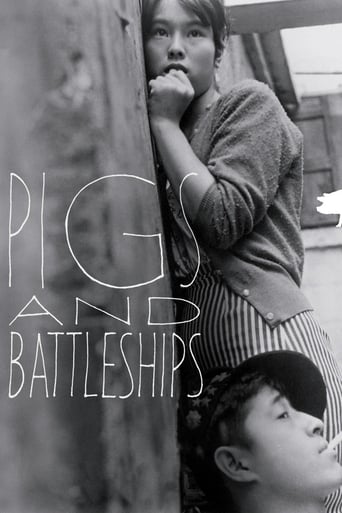treywillwest
There is no freedom in the world, only freedom from the world (or at least from the hegemony of American imperialism).
Perhaps those with the best chances of achieving a bit of such freedom are, ironically, those who seem most commodified by imperialism- in this case women in post-war Japan, deciding to leave behind the world of desire.
The scenes with the pigs are really cool.
christopher-underwood
Rampaging yakuza of the juvenile type, bad losers at mahjong, lots of screaming, running about and overacting. Sound familiar? I'm afraid so and it was only about halfway through I realised this was probably intended as a comedy. To be fair to director Shohei Imamura this is a 1961 film and was at the forefront of the Japanese 'New Wave'. Prior to this, running and jumping about film, most of Japanese cinema had been much more mannered, serene and dedicated to promoting the beauty and art of the Japanese way of life. Here at least an angry man is putting his foot down and having a go at the US occupation forces and their parasitic brethren, the aforementioned, yakuza. Not an easy watch, not least because everyone (excepting one) is horrible, and the comedic moments are just not funny any more, even if they seemed so to a far eastern cinemagoer almost 60 years ago.
kurosawakira
"This film is entirely fictional" states the film in the very beginning, lingering purposefully on the faces of bawling drunk Americans wandering the nightly streets, some harassed by, others looking for company. You don't really have to know Imamura at all to recognize the delicious irony. The beginning is so full of impressions, smells and life only Welles' "Touch of Evil" (1958) bests this in how in just a few minutes we're completely in the place and breathe its air. The sweaty chaos of the close-leaning alleys, kisses beneath stairs.Welles is also echoed in the beautifully fluent tracking shots. It's interesting to read Imamura's statements made during the sixties and later, when he recalls Ozu's intention of a highly aestheticized cinema, and his own, more anthropological, perhaps more real. These kinds of comments distracted me for a long time – I wasn't expecting visually strong films, which Imamura's are, neither was I prepared to see so many fresh ideas, of which there are many.I'm not completely satisfied with the ending, but I'll have to wait and see whether it'll grow on me. It is, on one hand, a successful melange of both the sadistic and ironic, but on the other it brings the film to a close perhaps too neatly. Not that I have any idea as to how to make it better, but it's too much of a showdown, and although Imamura plays it to great comic effect with a tragic undersong, it's a bit too excessive to my liking.The Criterion Collection has released this on DVD (Region 1) as part of the 'Pigs, Pimps & Prostitutes' boxset that also includes "Akasen satsui" ('Intentions of Murder', 1963) and "Nippin konchûki" ('The Insect Woman', 1963). Masters of Cinema have released this on a Region B Blu- ray that also includes an early Imamura film, his debut actually, "Nusumareta yokujô" ('Stolen Desire', 1958).
nadamada
It's really interesting to see one of the early works of Imamura. This film includes epitomes of the overall style of the great director: depiction of the lower, outlaw parts of Japanese society; criticizing both the authority and the society for their conformism with prevailing conditions; use of animals(namely pigs for this film) as an allegory for individuals (here it should be underlined that this object of allegory beats up its master!); and characterizing women as determined individuals who have power within the society, and who are more conscious than men. In order to trace the sources of the stylized director who made brilliant films like Kuroi Ame, Narayama bushiko, and Unagi, this film is a must see.


